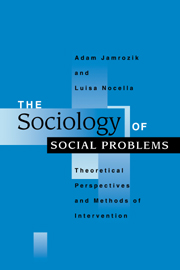Book contents
- Frontmatter
- Contents
- List of Tables
- List of Figures
- Preface and Acknowledgements
- 1 Introduction: Theoretical Perspectives on Social Problems
- 2 Contemporary Perspectives on Social Problems
- 3 Methods of Intervention in Social Problems
- 4 Social Actors in Social Problems
- 5 Challenges of Contemporary Social Problems
- 6 Social Problems in the Residualist Conversion Perspective
- 7 Inequality – The Underlying Universal Issue in Social Problems
- 8 The Social Construction of Family Problems
- 9 The Problem of Social Order
- 10 The Theory of Residualist Conversion: Does it Meet the Test?
- 11 Conclusions and Implications
- Bibliography
- Index
3 - Methods of Intervention in Social Problems
Published online by Cambridge University Press: 29 March 2011
- Frontmatter
- Contents
- List of Tables
- List of Figures
- Preface and Acknowledgements
- 1 Introduction: Theoretical Perspectives on Social Problems
- 2 Contemporary Perspectives on Social Problems
- 3 Methods of Intervention in Social Problems
- 4 Social Actors in Social Problems
- 5 Challenges of Contemporary Social Problems
- 6 Social Problems in the Residualist Conversion Perspective
- 7 Inequality – The Underlying Universal Issue in Social Problems
- 8 The Social Construction of Family Problems
- 9 The Problem of Social Order
- 10 The Theory of Residualist Conversion: Does it Meet the Test?
- 11 Conclusions and Implications
- Bibliography
- Index
Summary
Social problems are complex phenomena composed of a range of interconnected processes. An adequate understanding of a social problem as a social phenomenon has to include the perception of its genesis – that is, the causal links to social activities that ‘create’ the problem, the social actors who identify the problem, the population particularly affected by the problem, the nature of the perceived threat, and the applied methods of intervention intended to alleviate, control or solve the problem. An essential part of this understanding is the identification of the social actors in all these processes.
In this chapter we examine the methods of intervention in social problems, focusing first on the role of theories and research, and then on the activities that are implemented as the response to identified social problems. In this approach we give attention to the role of the state and examine responses to social problems from the perspective of the three-level structure of activities, illustrated schematically in Figure 1.1 (see page 11). We note that each level of social organisation does not only represent different activities, but that activities at each level are likely to be guided by different values, interests and theoretical orientations. Values, interests and theoretical orientation at one level are often incompatible with those at the other levels. At each level there are also constraints that limit the extent and nature of activities.
- Type
- Chapter
- Information
- The Sociology of Social ProblemsTheoretical Perspectives and Methods of Intervention, pp. 39 - 60Publisher: Cambridge University PressPrint publication year: 1998



